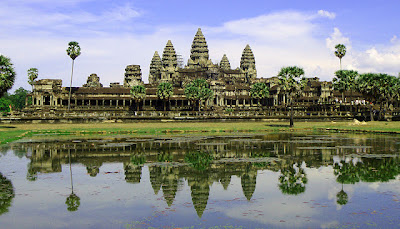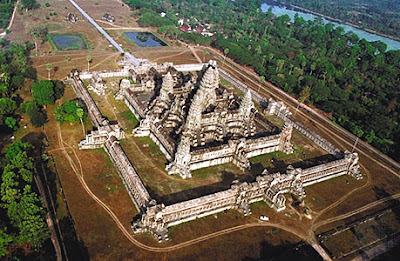Angkor Wat (Cambodia-Country) is not only the largest Hindu Temple, but also one of the wonders of the word. Yet, unknown to many Hindus all around! An architectural marvel and a piece of world heritage. Indians know more about Taj Mahal and almost nothing about this temple at Angkor Wat. Religion apart, this beautiful temple and it's intricate architectural wonder that signifies a symbol of Science and Mathematics in ancient times. There might not have been any Civil Engineering at that time, but even today the Engineers of Modern days, will have to bet their heads to recreate smething like this. Likewise, there are many wonders which people do not know about. We are lost in Eiffel Tower and things like Egyptian Pyramids, but there are lot more of Indian marvels and structures, in other places - why, even in China, Japan & Singapore also!
 |
Angkor Wat (or Angkor Vat) is a temple at Angkor, Cambodia, built for king Suryavarman II in the early 12th century as his state temple and capital city. The largest and best-preserved temple at Angkor, it is the only one to have remained a significant religious centre- first Hindu, then Buddhist- since its foundation. The temple is the epitome of the high classical style of Khmer architecture. It has become a symbol of Cambodia, appearing on its national flag, and it is the country's prime attraction for visitors drawn by its architecture, its extensive bas-reliefs and the numerous devatas adorning its walls.
Angkor is one of the most important archaeological sites in South-East Asia. Stretching over some 400 km2, including forested area, Angkor Archaeological Park contains the magnificent remains of the different capitals of the Khmer Empire, from the 9th to the 15th century. They include the famous Temple of Angkor Wat and, at Angkor Thom, the Bayon Temple with its countless sculptural decorations. UNESCO has set up a wide-ranging programme to safeguard this symbolic site and its surroundings.
Etymology
The modern name, Angkor Wat, means "City Temple"; Angkor is a vernacular form of the word nokor, which comes from the Sanskrit word nagar. Wat is the Khmer form of the Pali word "vatthu", meaning "temple grounds". Prior to this time the temple was known as Preah Pisnulok (Vara Vishnuloka in Sanskrit), after the posthumous title of its founder.
Brief synthesis
The park is inhabited, and many villages, some of whom the ancestors are dating back to the Angkor period are scattered throughout the park. The population practices agriculture and more specifically rice cultivation
Criterion (i): The Angkor complex represents the entire range of Khmer art from the 9th to the 14th centuries, and includes a number of indisputable artistic masterpieces (e.g. Angkor Wat, the Bayon, Banteay Srei).
Criterion (ii): The influence of Khmer art as developed at Angkor was a profound one over much of South-east Asia and played a fundamental role in its distinctive evolution.
Criterion (iii): The Khmer Empire of the 9th-14th centuries encompassed much of South-east Asia and played a formative role in the political and cultural development of the region. All that remains of that civilization is its rich heritage of cult structures in brick and stone.
Criterion (iv): Khmer architecture evolved largely from that of the Indian sub-continent, from which it soon became clearly distinct as it developed its own special characteristics, some independently evolved and others acquired from neighboring cultural traditions. The result was a new artistic horizon in oriental art and architecture.
Integrity
The Angkor complex encompasses all major architectural buildings and hydrological engineering systems from the Khmer period and most of these “barays” and canals still exist today.
All the individual aspects illustrate the intactness of the site very much reflecting the splendor of the cities that once were.
The site integrity however, is put under dual pressures:
a) endogenous: exerted by more than 100,000 inhabitants distributed over 112 historic settlements scattered over the site, who constantly try to expand their dwelling areas;
b) exogenous: related to the proximity of the town of Siem Reap, the seat of the province and a tourism hub.
Authenticity
Previous conservation and restoration works at Angkor between 1907 and 1992, especially by the École Française d’Extrême-Orient (EFEO), the Archaeological Survey of India, the Polish conservation body PKZ, and the World Monuments Fund have had no significant impact on the overall authenticity of the monuments that make up the Angkor complex and do not obtrude upon the overall impression gained from individual monuments
History of Angkor Wat Temple
Historical Description
The initial design and construction of the temple took place in the first half of the 12th century, during the reign of Suryavarman II (ruled 1113 – c. 1150). Dedicated to Vishnu, it was built as the king's state temple and capital city. As neither the foundation stela nor any contemporary inscriptions referring to the temple have been found, its original name is unknown, but it may have been known as Vrah Vishnu-lok ( literally "Holy Vishnu'-Location'", Old Khmer' Cl. Sanskrit). after the presiding deity. Work seems to have ended shortly after the king's death, leaving some of the bas-relief decoration unfinished. In 1177, approximately 27 years after the death of Suryavarman II, Angkor was sacked by the Chams, the traditional enemies of the Khmer. Thereafter the empire was restored by a new king, Jayavarman VII, who established a new capital and state temple (Angkor Thom and the Bayon respectively) a few kilometres to the north.
In the late 13th century, Angkor Wat gradually moved from Hindu to Theravada Buddhist use, which continues to the present day. Angkor Wat is unusual among the Angkor temples in that although it was somewhat neglected after the 16th century it was never completely abandoned, its preservation being due in part to the fact that its moat also provided some protection from encroachment by the jungle.
One of the first Western visitors to the temple was António da Madalena, a Portuguese monk who visited in 1586 and said that it "is of such extraordinary construction that it is not possible to describe it with a pen, particularly since it is like no other building in the world. It has towers and decoration and all the refinements which the human genius can conceive of." However, the temple was popularised in the West only in the mid-19th century on the publication of Henri Mouhot's travel notes. The French explorer wrote of it:
"One of these temples—a rival to that of Solomon, and erected by some ancient Michelangelo—might take an honourable place beside our most beautiful buildings. It is grander than anything left to us by Greece or Rome, and presents a sad contrast to the state of barbarism in which the nation is now plunged."
Mouhot, like other early Western visitors, found it difficult to believe that the Khmers could have built the temple, and mistakenly dated it to around the same era as Rome. The true history of Angkor Wat was pieced together only from stylistic and epigraphic evidence accumulated during the subsequent clearing and restoration work carried out across the whole Angkor site.
There were no ordinary dwellings or houses or other signs of settlement including cooking utensils, weapons, or items of clothing usually found at ancient sites. Instead there is the evidence of the monuments themselves.
Angkor Wat required considerable restoration in the 20th century, mainly the removal of accumulated earth and vegetation.[7] Work was interrupted by the civil war and Khmer Rouge control of the country during the 1970s and 1980s, but relatively little damage was done during this period other than the theft and destruction of mostly post-Angkorian statues.
The temple is a powerful symbol of Cambodia, and is a source of great national pride that has factored into Cambodia's diplomatic relations with its neighbour Thailand, France and the United States. A depiction of Angkor Wat has been a part of Cambodian national flags since the introduction of the first version circa 1863.[9] From a larger historical and even transcultural perspective, however, the temple of Angkor Wat did not became a symbol of national pride sui generis but had been inscribed into a larger politico-cultural process of French-colonial heritage production in which the original temple site was presented in French colonial and universal exhibitions in Paris and Marseille between 1889 and 1937.
The splendid artistic legacy of Angkor Wat and other Khmer monuments in the Angkor region led directly to France adopting Cambodia as a protectorate on 11 August 1863 and invading Siam to take control of the ruins. This quickly led to Cambodia reclaiming lands in the northwestern corner of the country that had been under Siamese (Thai) control since 1351 AD (Manich Jumsai 2001), or by some accounts, 1431 AD.[11] Cambodia gained independence from France on 9 November 1953 and has controlled Angkor Wat since that time.
During the midst of the Vietnam War, Chief of State Norodom Sihanouk hosted Jacqueline Kennedy in Cambodia to fulfill her "lifelong dream of seeing Angkor Wat."
In January 2003 riots erupted in Phnom Penh when a false rumour circulated that a Thai soap opera actress had claimed that Angkor Wat belonged to Thailand.
Aerial view of Angkor Wat
Miniature model of the central structure of Angkor Wat. In the foreground the cruciform terrace which lies in front of the central structure.
Image Courtesy www.whc.unesco.org
Click here to read more religious places














0 comments:
Post a Comment
Please give your valuable opinion.........